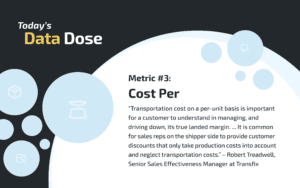Today’s Data Dose is an original Transfix series that helps shippers identify the key metrics they should track to get the most out of their supply chain. Which data measurements should an organization prioritize, considering their unique pain points, network, and goals?
We’ve got answers. We’ve got experts.

Metric 3: Cost Per
Shippers can take a look at costs per shipment, per pallet, or per mile. And if they want to get more granular, how about “cost per unit,” or “cost per pound.” “Cost per ___” may seem to be one of the most fundamental measurements an organization can analyze, but perhaps that’s part of the issue with its underutilization. Is this metric too basic to bother with?
“Transportation cost on a per-unit basis is important for a customer to understand in managing, and driving down, its true landed margin,” said Robert Treadwell, Senior Sales Effectiveness Manager at Transfix. “Some customers may also look at ‘cost per pallet’ as a unit, as well. It is common for sales reps on the shipper side to provide customer discounts that only take production costs into account and neglect transportation costs.”
When looking across an organization’s shipping spend, deviations in “cost per” can help identify problem areas—and, more importantly—ways to address them. If, for example, a given distribution center’s metrics for “cost per refrigerated pallet” is noticeably higher than another center’s, it’s time to ask questions about where and when those costs are accumulating.
When a shipping strategy isn’t working, this metric can help identify why. If the components of a shipping process are generally bundled together at analysis time, it may be worthwhile to break them out into “Cost per A,” “cost per B,” and “cost per C.” This gives you more opportunity to look for individual outliers. It can also be helpful in identifying preferred carrier partners.
“Cost per” analyses generate great data for when you’re justifying the costs passed along to end customers. During the past year, media outlets like CNBC, Yahoo, and the L.A. Times have devoted lots of ink to the impact of shipping on the price of goods. In each story, the news is essentially the same: high diesel prices and supply chain problems are increasing the cost of goods and contributing to inflation. When client companies or end users object to the increased price of their widgets, it is helpful to point to “a __% increase in the cost of shipping each unit.”
When considering which metrics warrant examination, don’t discount a measurement simply because it seems too simplistic. “Cost per ___” metrics may not be too “basic” for your analysis . . . they might be fundamental.
Stay tuned for our next Data Dose, #4: “Transit and Wait Times.” Click here to learn more about Transfix’s Intelligent Freight Platform.




![[Webinar Recap] Diesel Download: A 2024 Outlook to Prepare for a Volatile Year Ahead](https://transfix.io/hubfs/iStock-1392574169.jpg)